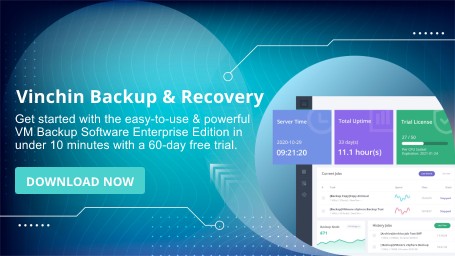-
Principles and Effects of Data Deduplication Technology
-
Deduplication Feature in Windows Server
-
Use Cases of Windows Server Deduplication Feature
-
Implementation Methods of Windows Server Deduplication
-
Comprehensive Windows Server Protection Solution
-
Windows Server Backup Deduplication FAQs
-
Conclusion
As the scale of enterprise data continues to expand, the problem of duplicate data in storage devices has become increasingly serious. Windows Server, as an operating system widely used in enterprise environments, provides various storage management features, one of which is deduplication technology. This article will detail the deduplication technology in Windows Server, including its principles, effects, and implementation methods, aiming to help readers better understand and apply this technology to improve storage efficiency and reduce enterprise storage costs.
Principles and Effects of Data Deduplication Technology
Data deduplication technology is not unique to Windows Server, but a widely applied technology in the storage field. As early as the late 1980s to early 1990s, the storage industry began exploring ways to eliminate duplicate data to improve storage efficiency, especially in enterprise environments. As enterprise data volumes grew, storage devices faced space wastage issues, particularly for backup files, virtual machine image files, and the large amounts of duplicate content in version control systems.
The purpose of data deduplication technology is to find and remove duplicate data in storage devices, thereby freeing up valuable storage space. The deduplication technology in Windows Server is mainly based on two principles: hash comparison and byte comparison.
1. Hash Comparison
Hash comparison is a fast method for determining whether files are duplicates. It performs a hash calculation on the file contents, generating a unique identifier known as a hash value. If two files have the same hash value, it indicates that their contents are identical, and one file can be safely deleted. The advantage of hash comparison is speed, as it only needs to calculate the hash value once, rather than comparing the entire file content.
2. Byte Comparison
Byte comparison directly compares the byte streams of two files. If the byte streams are exactly the same, their contents are duplicate and can be deleted. While byte comparison is accurate, it is more time-consuming than hash comparison, especially when dealing with large files.
By using these two principles, Windows Servers deduplication technology can significantly improve the space utilization of storage devices. Removing duplicate data not only reduces storage costs but also improves backup and recovery speed, as the backup and recovery processes involve fewer data.
Deduplication Feature in Windows Server
The origin of the data deduplication feature in Windows Server can be traced back to early storage technology demands and developments. Introduced as a standard feature in Windows Server 2012, this technology optimizes storage efficiency by eliminating redundant data. This feature is primarily used to reduce the use of storage space, especially when handling large volumes of similar data, particularly in file servers, backup storage, and virtual machine environments. The underlying principles involve various algorithms and technologies, which are primarily divided into core components such as data block segmentation, hash comparison, storage reference tables, and deduplication management mechanisms. Through ongoing optimization of deduplication algorithms and performance, Microsoft has developed it into a powerful storage optimization tool that provides a more efficient and cost-effective solution for large-scale data storage.
Use Cases of Windows Server Deduplication Feature
Windows Server's data deduplication feature offers significant advantages, especially in file server and backup storage environments. For example:
File Servers: By using deduplication, Windows Server can reduce storage space consumption. For instance, shared documents, templates, or multiple versions of files can be stored as a single copy, with other versions referencing the original data blocks to save storage space.
Backup Environments: Deduplication can significantly reduce backup storage space requirements, especially between incremental backups. It can store only the duplicate portions of the backup data once, greatly reducing storage usage and improving backup efficiency.
Virtualization Environments: By deduplicating VHD/VHDX files, storage requirements for virtual machine images can be reduced, especially when multiple virtual machines use the same operating system, allowing multiple VMs to share a common base image rather than storing a full OS copy for each virtual machine.
Microsoft Exchange Server: Data deduplication can reduce the storage of duplicate data in email attachments and email bodies, thus saving disk space. This is especially important for long-term email storage and archiving.
Implementation Methods of Windows Server Deduplication
GUI Setup for Deduplication
1. In Server Manager, add the Deduplication role.
2. Navigate to Server Manager > File and Storage Services > Volumes.
3. Right-click the volume to perform deduplication and click Deduplicate.
4. Choose the deduplication data mode: Default for general file servers, Hyper-V for Virtual Desktop Infrastructure (VDI) servers, Backup for virtualized backup servers.
5. Set up the deduplication schedule, enable throughput optimization, and select the days, start time, and duration. (Default settings will apply, typically running during weekends or idle time).
Deduplicate files older than a specified number of days (default is 3 days), which can be changed to 0 days to deduplicate all files.
Note: Files that haven't been modified for over 3 days will be deduplicated.
6. Once configuration is complete, you can view the disk space savings in "Server Manager > File and Storage Services > Volumes". (It’s recommended to check after a week for files with more data).
PowerShell Command to Enable Deduplication
Enable-DedupVolume -Volume <Volume-Path> -UsageType <Selected-Usage-Type>
Where “<Volume-Path>” is the volume (i.e., drive letter) to enable, and “<UsageType>” can be one of three options: Default for file servers, Hyper-V for Virtual Desktop Infrastructure (VDI) servers, and Backup for virtualized backup servers.
PowerShell command to execute deduplication with maximum resources:
Start-DedupJob -Type Optimization -Volume <Your-Volume-Here> -Memory 100 -Cores 100 -Priority High
Remove and Rollback Deduplication
Deduplication can reduce disk usage, but if not used properly, it may increase IO. Additionally, this feature divides the disk into chunks, which can make defragmentation difficult when disk usage is high. Therefore, it may sometimes be necessary to disable deduplication and undo the optimization. This can be done using the following steps:
1. Enter PowerShell in Administrator mode.
2. Run the command to check the deduplication status:
Get-DedupStatus -Volume D:
3. Disable deduplication:
Disable-DedupVolume -Volume D:
4. If necessary, rollback the deduplication optimization:
Start-DedupJob -Volume D: -Type Unoptimization
5. Check the task execution status:
Get-DedupJob
6. Restart the computer to complete the process.
Note: This process can be time-consuming, so use it with caution!
When performing data deduplication on Windows Server, the following points should be noted:
Ensure that a full backup is performed to prevent data loss in case of accidental deletion.
Deduplication is a computationally intensive operation, so it is best to choose an appropriate time to run it to avoid impacting business activities.
The threshold for deduplication can be set to reduce the risk of accidental deletions. Administrators should adjust the threshold based on actual conditions to achieve the best results.
Comprehensive Windows Server Protection Solution
Vinchin Backup & Recovery provides comprehensive support for various versions of Windows Server, including 2003/2003 R2, 2008/2008 R2, 2012/2012 R2, and 2016, 2019, 2022. With features such as batch scheduling and automated full, incremental, and differential backups, it simplifies protecting critical Windows workloads. Vinchin's volume-level Continuous Data Protection (CDP) ensures real-time replication, near-zero RPO and RTO, and automated failover, providing strong disaster recovery capabilities. Additionally, Vinchin supports agentless backups for Hyper-V on Windows servers, allowing easy integration of virtual machines into the backup system without requiring agents in each guest OS.
Vinchin also enhances security with ransomware protection and enables instant recovery of both physical servers and VMs, minimizing downtime by directly mounting backup data for fast restoration. These features make it a reliable solution for safeguarding enterprise workloads on Windows Server.
To backup the server with Vinchin, just follow the steps below:
1.Select the server on the host

2.Then select backup destination

3.Configure backup strategies

4.Finally submit the job
Try the 60-day full featured free trail of Vinchin Backup & Recovery now. Or, you can contact Vinchin directly for more information.
Windows Server Backup Deduplication FAQs
1. How much storage can be saved by using deduplication?
The storage savings vary depending on the type of data being backed up. In some cases, deduplication can reduce storage requirements by 30% to 80%, depending on the redundancy in the data.
2. Can I use deduplication in virtualized environments with Hyper-V or VMware?
Yes, deduplication can be used in virtualized environments to reduce the storage needed for virtual machine backups. For example, you can store Hyper-V or VMware virtual disk files (VHD, VMDK) on a volume with deduplication enabled. Also, when you backup those VMs with Vinchin Backup & Recovery, the deduplication feature it offered can help you save a significant amount of storage.
Conclusion
Windows Server's deduplication technology offers a powerful solution for optimizing storage efficiency in enterprise environments. By eliminating redundant data through hash and byte comparison methods, it reduces storage costs, enhances backup performance, and improves overall system efficiency. With its seamless integration into file servers, backup environments, and virtualized infrastructures, implementing deduplication can significantly streamline data management, providing a cost-effective way to handle the growing demands of modern enterprise storage.
Share on:







